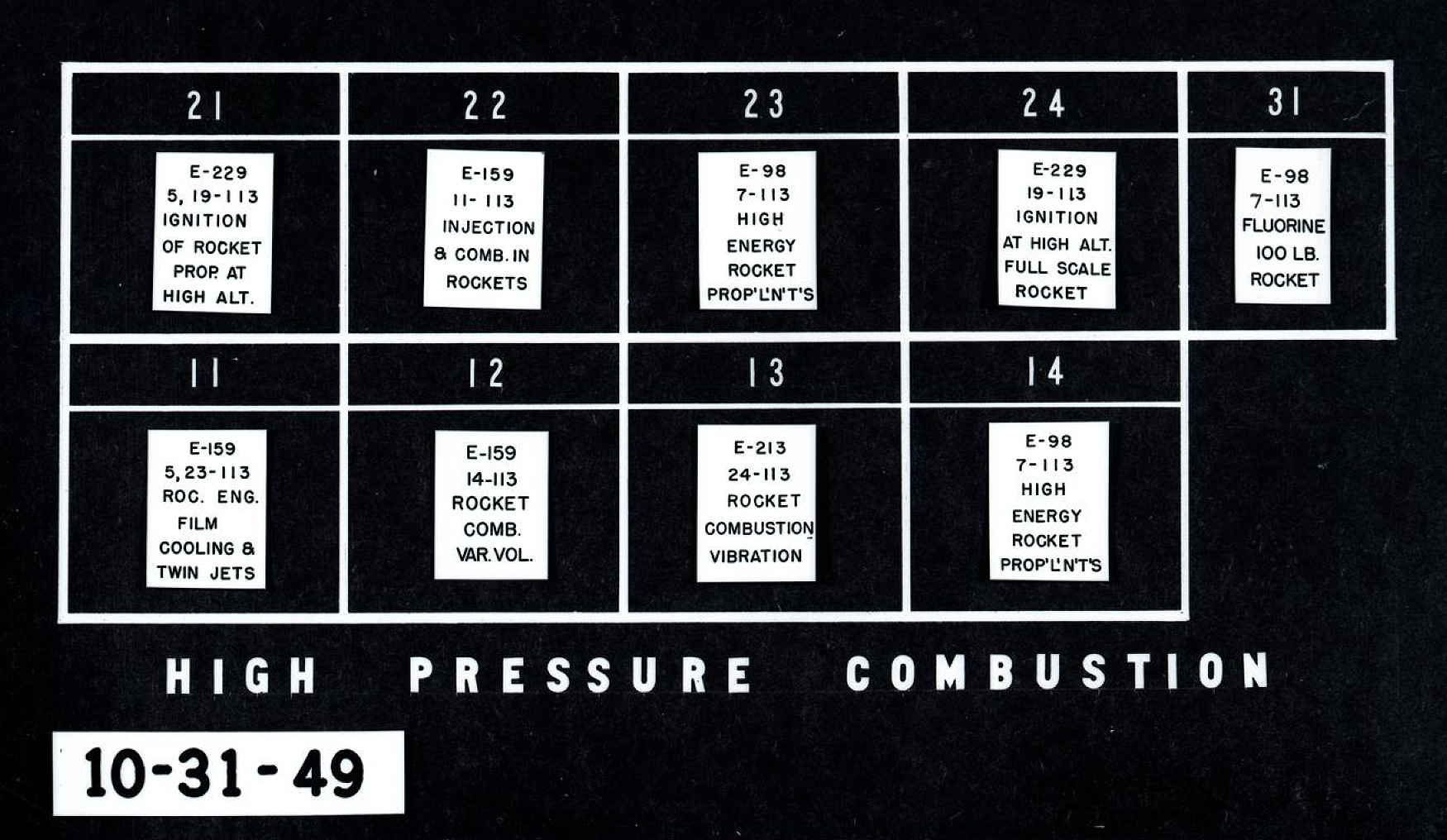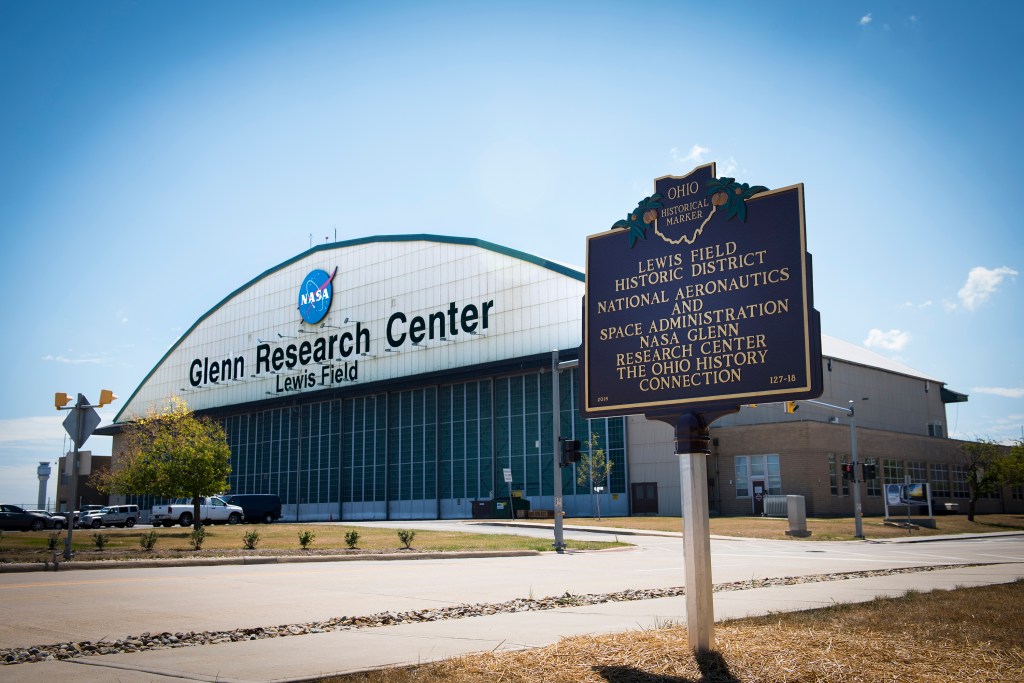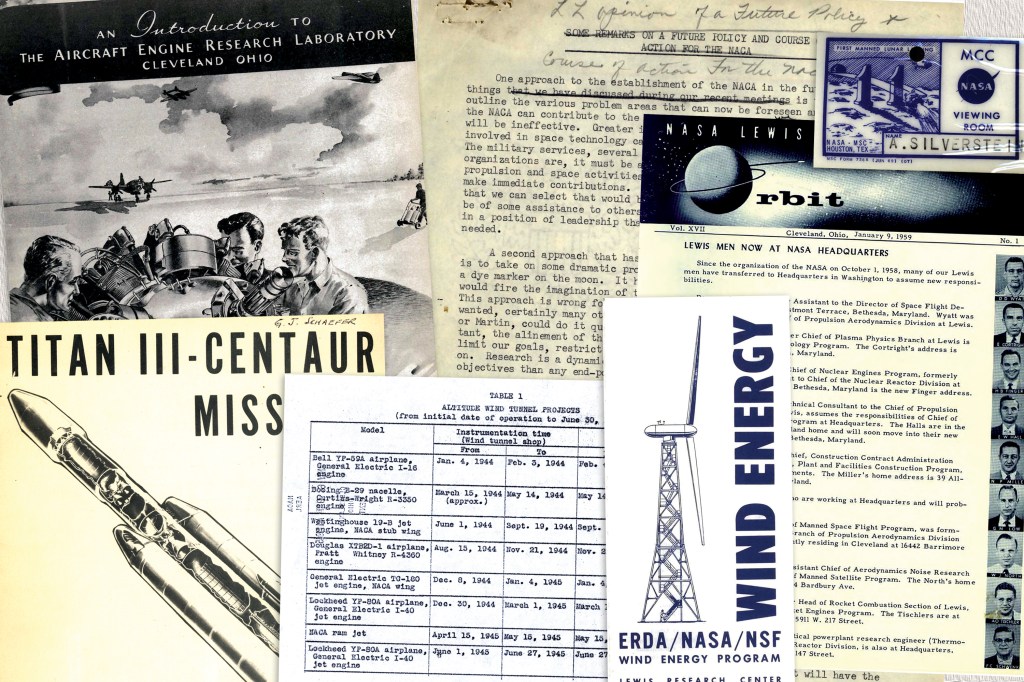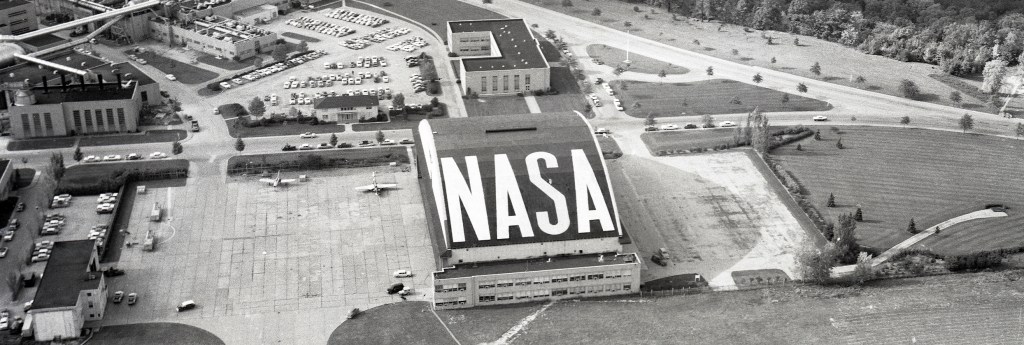NASA Glenn Research Center
Historic Facilities
Rocket Laboratory
Events Timeline
1944
- US Army Air Corps asks the NACA build a rocket facility.
1945
- Construction of Cells 11-14 in the summer of 1945.
- First engine tests conducted at Rocket Lab in September 1945.
1947
- Rocket researchers give talks at the 1947 NACA Inspection.
1948
- Hydrogen engine testing at Ohio State University and Aerojet.
- Laboratory hosts Fuels Conference discussing high-energy fuels.
- Construction of Rocket Lab Cells 21-24.
1949
- Reorganization expands Rocket Section into a branch.
- Rocket testing presentations made at the 1949 NACA Inspection.
1950
- High Pressure Combustion Laboratory renamed the Rocket Laboratory.
1951
- NACA establishes a Special Subcommittee on Rocket Engines.
1952
- NACA approves increase in rocket resources and funding.
1954
- First liquid hydrogen-liquid oxygen engine test at the laboratory.
- Acquisition of hydrogen liquefier.
1955
- Exhaust scrubber added to Cell 22.
1957
- Soviet Union launches Sputnik.
- Lab hosts NACA Inspection and Flight Propulsion Conference.
- Rocket Engine Test Facility begins operation.
- First regeneratively-cooled hydrogen-fluorine engine run.
1958
- NACA leases land at Plum Brook to build the Rocket Systems Area.
- NASA is established, and the laboratory becomes Lewis Research Center.
- Saturn and Centaur rocket programs established.
1959
- Silverstein Committee recommends use of high-energy fuels in rockets.
1963
- First successful Atlas-Centaur launch in November 1963.
1964
- First Saturn launch with hydrogen-fueled stages.
1966
- Center reorganizes to increase aeronautics work.
1974
- NASA authorizes energy-related research efforts.
1981
- First space shuttle mission is launched.
- Facility renamed the Combustion Research Laboratory.
1984
- Space Station Freedom program officially begins.
1989
- Combustion Research Laboratories renamed Rocket Laboratories.
- Announcement of the Space Exploration Initiation.
1990
- NASA initiates the High-Speed Civil Transport program.
- Start of upgrades to Cells 11 and Cell 13.
1991
- Cold War ends with dissolution of the Soviet Union.
1993
- International Space Station development announced.
- Modifications to Cell 11.
1994
- NASA initiates the Reusable Launch Vehicle (RLV) program.
1996
- Rocket Laboratories renamed Research Combustion Laboratory.
1999
- Center is renamed the Glenn Research Center.
2000
- NASA begins removing unused structures.
2004
- NASA initiates Constellation Program.
2007
- Center announces master plan for campus.
2016
- Planning for Rocket Lab demolition begins.
2021
- Majority of Rocket Lab are demolished.
Testing Timeline
A non-comprehensive list of testing performed at the Rocket Laboratory and approximate dates.
1940s
1945
- Hydrogen peroxide film cooling (Cell 13).
- Special fuels testing for the Army Air Force (Cell 11).
- Aerojet jet-assisted-takeoff (JATO) engine (Cell 12).
- Hydrogen peroxide film cooling (Cell 14).
1946
- High-energy rocket propellants in 100-pound-thrust engine (Cell 11).
- Water film cooling (Cell 12).
- Nitric acid and aniline JATO rocket engine (Cell 13).
- 1000-pound-thrust liquid oxygen and gasoline engine (Cell 13).
1947
- Fuel rating tests with 500lb liquid-cooled transparent engine (Cell 11).
- Internal-film cooling of rocket nozzles (Cell 13).
- Injection and variable-volume combustion in rocket engines (Cell 13).
- Liquid diborane and liquid oxygen in 100-pound-thrust engine (Cell 14).
1948
- Fluorine and hydrazine in 100-pound-thrust rocket engine (Cell 31).
1949
- Temperature survey of two parallel injector jets (Cell 11).
- Rocket engine film cooling (Cell 11).
- Combustion vibrations in liquid engines (Cell 12).
- Rocket combustion vibrations (Cell 13).
- Ignition of rocket propellants at simulated altitudes (Cell 14).
- Injection and combustion in rockets (Cell 21).
- High-energy rocket propellants (Cell 23).
- Starting of rocket engine in simulated altitude conditions (Cell 24B).
1950s
1950
- Combustion instability in an acid and heptane rocket (Cell 13).
- Ignition of rocket propellant at low temperatures (Cell 14).
- Rocket engine film cooling (Cell 14).
- Combustion vibrations in rocket engines (Cell 23).
- Internal film cooling for rocket engines (Cell 31).
- High-energy rocket propellants (Cell 31).
1951
- Liquid fluorine and liquid diborane in 100-pound-thrust engine (Cell 14).
- 1000-pound-thrust rocket engine (Cell 23).
- Ignition delay with a small-scale rocket at simulated altitude (Cell 24B).
1952
- Screaming in a 100-pound-thrust rocket engine (Cell 13).
- Combustion oscillations in rocket engines (Cell 14).
- Screaming in rocket chamber (Cell 21B).
- Impinging jet injector spray studies (Cell 21).
- Ignition delays of alkyl thiophoshites with fuming nitric acids (Cell 24B).
- Engine starting with nitrogen and ammonia oxides (Cell 24).
- Liquid fluorine and liquid ammonia in a 100-pound-thrust engine (Cell 31).
- Disposal of rocket exhaust gases (Cell 31).
1953
- Fluorine and ammonia combination in a 1000-pound-thrust engine (Cell 14).
- Photographic investigation of combustion in a transparent engine (Cell 21).
- Photographic study of rotary screaming (Cell 23B).
1954
- Injection studies with a 200-pound-thrust engine (Cell 13).
- Regenerative cooling in a 5000-pound-thrust liquid oxygen and JP-4 engine (Cell 22).
- Liquid hydrogen and liquid oxygen in a 5000-pound-thrust engine (Cell 22).
1955
- JP-4 fuel with FLOX mixtures in a 1000-pound-thrust engine (Cell 14).
- Low temperature starting of 200-pound-thrust JP-4 and nitric acid engine (Cell 24B).
- Performance of FLOX and JP-4 in a 200-pound-thrust rocket engine (Cell 24).
- Chemical igniters for jet fuel and nitric acid rocket engines (Cell 24A).
- Ignition delay of furfuryl alcohol and butyl mercaptans (Cell 24B).
- Effects of combustion chamber variations on ignition delay (Cell 24B).
1956
- Liquid hydrogen and liquid fluorine propellant combination (Cell 11).
- Heat transfer at supersonic speeds (Cell 11).
- Screaming of gas propellants (Cell 12).
- Hydrocarbon fuels with fluorine (Cell 13).
- Screaming in rocket motor (Cell 13).
- Hydrocarbon fuel with FLOX in 1000-pound-thrust engine (Cell 14).
- Separated flow in Roe engine (Cell 14).
- Fluorine and ammonia in Roe engine (Cell 22).
- Jet fuel with FLOX propellant combination (Cell 22).
- Low temperature engine starting (Cell 24).
- Altitude performance of a JP-4 and liquid oxygen engine (Cell 21A).
- Hydrocarbon fuel with nitric acid (Cell 31).
1957
- Droplet size and screaming engine (Cell 12)
- Effect of injector size (Cell 13).
- Liquid oxygen injection sprays (Cell 14).
- Fluorine and ammonia propellant combination (Cell 22).
- Liquid hydrogen and liquid oxygen propellant combination (Cell 22).
- JP-4 and liquid oxygen propellant combination (Cell 22).
- Liquid hydrogen and liquid fluorine propellant combination (Cell 22).
- Performance of a hydrogen and fluorine regeneratively-cooled engine (Cell 22).
- Hydrocarbon and liquid oxygen propellant combinations (Cell 22).
- Liquid oxygen with JP-4, and kerosene in a rocket engine (Cell 23).
- Altitude starting of a 1000-pound-thrust solid rocket (Cell 24B).
- Ignition lag of self-igniting fuel and nitric acid (Cell 24B).
- Liquid oxygen and heptane propellant combination (Cell 24).
- Geometry and screaming in rocket engine (Cell 24).
1958
- Liquid hydrogen and liquid fluorine propellant combination (Cell 11).
- Screaming in rocket engine (Cell 13).
- Screaming in rocket engine (Cell 14).
- Experimental performance of a hydrogen and fluorine rocket engine (Cell 22B).
1959
- Evaluation of rocket exhaust diffusers with various nozzles (Cell 23).
- Effect of temperatures on hydrogen peroxide thrusters (Cell 24B).
1960s
1960
- Injectors for hydrogen and fluorine engines (Cell 22B).
1961
- Hydrogen and fluorine performance and ignition (Cell 21).
1963
- Design and cooling of a dump-cooled rocket (Cell 14).
1964
- Mercury-hydrogen high-temperature pebble bed heater (Cell 13).
- Injector flow tests with water (Cell 21B).
- Evaluation of ablative materials for storable-propellant rocket nozzles (Cell 21B).
- Hydrogen flow instability from large temperature increases (Cell 26).
- Self-pressurization of spherical liquid hydrogen tank (Cell 26).
1965
- Performance of bipropellant fractional-pound thrusters (Cell 24B).
1967
- Fuel deposits study (Cell 24).
- Performance of a water-electrolysis rocket (Cell 24B).
1968
- Development of improved throat inserts for ablative engines (Cell 21B).
- Evaluation of an oxidant-fuel-ratio-zoned injector (Cell 21B).
- Testing of a 1000lb thrust FLOX and propane ablative engine (Cell 22).
1969
- Tests of a combustor with air-atomizing fuel injection (Cell 11).
- Investigation of diffuser wall bleed and design to control inlet airflow (Cell 12).
1970s
1970
- Hydrazine rocket thruster (Cell 24B).
1971
- Performance of an asymmetric short annular diffuser (Cell 12).
- Characteristics of a welded rotor in a Lundell alternator (Cell 14).
1972
- Attitude-control thruster using hydrogen and oxygen (Cell 21B).
1974
- Hydrogen-Oxygen Magnetohydrodynamics Program (Cell 22)
- Centaur boost pump test (Cell 23).
1976
- Effect of hydroprocessing on jet fuel distillates (Cell 24C).
1977
- Effect of flameholder pressure drop on emissions (Cell 13).
- Lewis coal-fired, pressurized, fluidized-bed reactor test facility (Cell 13).
- Traction drive for a cryogenic boost pump (Cell 21).
- Burning Rate Rig (Cell 24).
1979
- Flametube studies for fuel control of fuel bound nitrogen (Cell 11).
1980s
1981
- Alternative fuel combustion characteristics in a gas turbine engine (Cell 23).
1983
- Combustor flame flashback study (Cell 11).
- Cold flow swirl combustor experiment (Cell 21).
1984
- Spray characteristics of an airblast atomizer (Cell 21).
- Single nozzle testing (Cell 21).
1985
- Hypersonic engine in a high heat flux environment (Cell 22).
- Alternative fuel combustion characteristics in a gas turbine engine (Cell 23).
1986
- Single nozzle testing (Cell 12).
- Hypersonic engine components in high-heat flux (Cell 22).
1987
- Catalytic ignition of hydrogen and oxygen propellants (Cell 21).
1989
- Carbon monoxide and oxygen ignition and combustion (Cell 21).
- Ignition and combustion of metallized propellants (Cell 21).
1990s
1990
- Cryogenic fuel jet mixing (Cell 13).
1991
- Hydrogen film coolant injection in a hydrogen and oxygen rocket (Cell 11).
- Comparison of flowfields in a hydrogen-oxygen rocket (Cell 11).
- Fuel-rich, catalytic reaction experiment (Cell 23).
1992
- Evaluation of oxide-coated iridium-rhenium chambers (Cell 11).
- Hydrogen-oxygen engine for combustion and nozzle studies (Cell 11).
- Heat transfer characteristics of a carbon monoxide and oxygen engine (Cell 21).
- Hypersonic engine experiments in a high heat flux environment (Cell 22).
1993
- Small rocket flowfield diagnostic chambers (Cell 11)x.
- Oxygen/RP-1/aluminum rocket heat transfer and combustion (Cell 21).
- Ceramic matrix composites thermal shock program (Cell 22).
- Thin film thermocouples (Cell 22).
- Pratt & Whitney transportation cooled seals experiment (Cell 22).
1994
- Spread Across Liquid Experiment pressure and ignition tests (Cell 22).
- Transpiration Cooled Ceramic Nozzles program (Cell 22).
1995
- Life testing of oxide-coated iridium/rhenium rockets (Cell 11).
- Performance comparison of two small rocket nozzles (Cell 11).
- Evaluation of the ignition process of carbon monoxide and oxygen (Cell 21).
- Ablative material testing for low-cost rocket engines (Cell 22).
- Hydrogen and liquid oxygen droplet measurements (Cell 32).
1996
- Electrolysis propulsion for spacecraft applications (Cell 11).
- Teledyne Ryan Ultra Lean Combustor (Cell 23).
- Coaxial injector for Laser Ignition Technology Program (Cell 32).
- Subscale gaseous hydrogen-oxygen rocket injector (Cell 32).
1997
- Rocket-in-a-Duct performance analysis (Cell 11).
2000s
2000
- Flow field of thruster having attached panel (Cell 22).
- Water electrolysis testing (Cell 24C).
- Evaluation of NASA GTX RBCC Flowpath (Cell 32).
2003
- Hydrogen-oxygen proton exchange membrane fuel cell stack (Cell 24C).
2004
- Low emission hydrogen combustors using lean direct injection (Cell 23).
- Actively-cooled ceramic matrix composite thrust cells.
2005
- Metallized gelled propellants in a pulse engine (Cell 21).
- GRCop-84 rocket thrust chambers (Cell 22).
2006
- Hydrogen fuel system design trades for high-altitude aircraft (Cell 21).
2008
- Liquid oxygen and methane glow plug igniter tests (Cell 21).
2009
- Integrated High Payoff Rocket Propulsion SiC Recession Model (Cell 22).
- 100-pound-thrust liquid oxygen and methane thruster (Cell 32).
2013
- Green Propellant Infusion Mission Thruster testing and plume diagnostics (Cell 11).
- Aerojet-Rocketdyne Manufacturing Innovation Project Injector (Cell 32).
NASA History
Return to Main Page
Return to the Rocket Laboratory main page to find additional information on the facility and its history.
Learn More


































